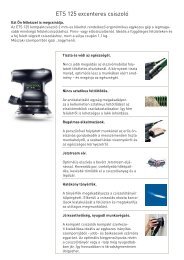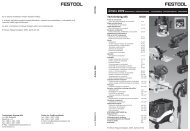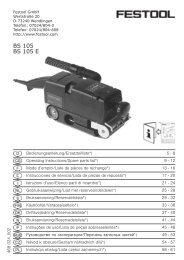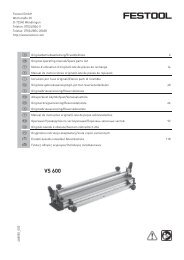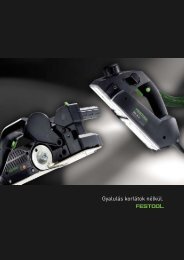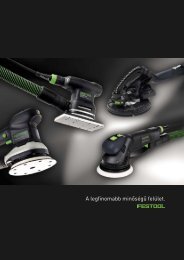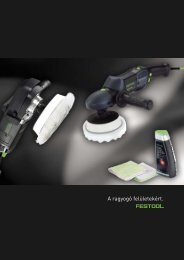RAP 80.02 E - Festool
RAP 80.02 E - Festool
RAP 80.02 E - Festool
- TAGS
- festool
- www.festool.hu
Create successful ePaper yourself
Turn your PDF publications into a flip-book with our unique Google optimized e-Paper software.
6.1 Rough speeds for work with different<br />
materials<br />
a) Polishing<br />
Work Setting<br />
Distribute polish 1-2<br />
Polishing sensitive surfaces<br />
(e.g. painted plastic parts) 3-4<br />
High-gloss polishing 5-6<br />
b) Sanding<br />
Work Setting<br />
Light sanding of thin topcoats 4-6<br />
Sanding “smearing” paints / varnishes 4-6<br />
Sanding off dry, cracked paint 6<br />
Removing anti-fouling paint 6<br />
Sanding out rust on varnished metal parts (6)<br />
Sanding thermoplastics 2-4<br />
Sanding wood 6<br />
Smoothing stained wood with<br />
sanding brush 2-4<br />
Cleaning sandstone, concrete,<br />
shuttering material 4-6<br />
( ) Only conditionally suitable<br />
7 AH-RAS 115 extractor hood<br />
7.1 Fitting (Fig. 2)<br />
Before fitting the hood, take care to<br />
ensure that the clamping lever is in the<br />
“released” position (2.2).<br />
Press the extractor hood firmly onto the<br />
clamping neck of the rotary polisher and fasten<br />
by pushing the clamping lever forwards<br />
(2.1).<br />
Do not start work if the hood extractor<br />
hood is not safely and firmly locked<br />
onto the clamping neck.<br />
If the clamping force should deteriorate after<br />
frequent use, adjust the clamping lever:<br />
• loosen screw (4.1) on clamping lever and<br />
remove clamping lever (4.2),<br />
• tighten square-head threaded bolt (4.3) by<br />
hand,<br />
• replace clamping lever and fasten with screw.<br />
The optimum position can be determined by<br />
closing the clamping lever before tightening<br />
the screw.<br />
7.2 Changing the position of the<br />
rotating handle<br />
The rotating additional handle can be also be<br />
fastened on the right of the extractor hood<br />
depending on the user’s personal preferences.<br />
It should be exchanged with the clamping lever.<br />
• Loosen screw (4.1) on clamping lever and<br />
remove clamping lever (4.2).<br />
• Remove square-head threaded bolt (4.3).<br />
• Loosen additional handle (5.2) with Allen key,<br />
size 6.<br />
The clamping lever and additional handle can<br />
8<br />
now be exchanged. Reassemble in reverse<br />
order.<br />
You can adjust the free-running of the rotating<br />
additional handle using the counternut (5.1)<br />
by clamping this against the hood with an openend<br />
spanner, size 13, before tightening the additional<br />
handle.<br />
7.3 Changing the brush insert<br />
Press the brush insert out by inserting a<br />
screwdriver into the square hole (5.5).<br />
Place the new brush insert into the groove,<br />
adjust the radius by bending slightly and push<br />
in firmly until the insert rests on the base of<br />
the hood.<br />
The bevel of the bristles must hereby point<br />
outwards.<br />
Two different brush inserts are available:<br />
• AH-RAS D 115 Poly (Order No. 484 727),<br />
contains 2 polyamide brushes (as<br />
replacements for worn brushes).<br />
• AH-RAS D 115 Metal (Order No. 484 728),<br />
contains 1 metal brush (for use on materials<br />
which produce sparks).<br />
7.4 Changing the sanding pad<br />
In normal cases the sanding pad (1.2) can be<br />
unscrewed from the working spindle by hand<br />
after the spindle stop (1.3) has been pressed.<br />
However, should the sanding pad sit firmly<br />
• Remove brush insert<br />
• Insert special key (5.3) through slot (5.4)<br />
into the tool’s key slot.<br />
• Press the spindle stop and loosen the tool by<br />
turning the special key.<br />
Always screw the sanding pad onto the<br />
working spindle by hand.<br />
This greatly facilitates a later loosening.<br />
7.5 Sanding and dust extraction<br />
Connect the hose (Ø 27 mm) of a<br />
<strong>Festool</strong> dust extractor to the adapter<br />
(3.2) on the rear of the rotary<br />
polisher’s casing.<br />
The brush (3.3) can be adjusted with the<br />
rotating handle (3.4).<br />
This permits an optimum adjustment to the<br />
respective working position.<br />
Always rotate the brush in the direction of flight<br />
of the sanding dust.<br />
When sanding metals and other<br />
materials which produce sparks, a<br />
spark trap (Order No. 484 733) must<br />
be fitted between the dust extractor<br />
and rotary polisher for safety reasons.



